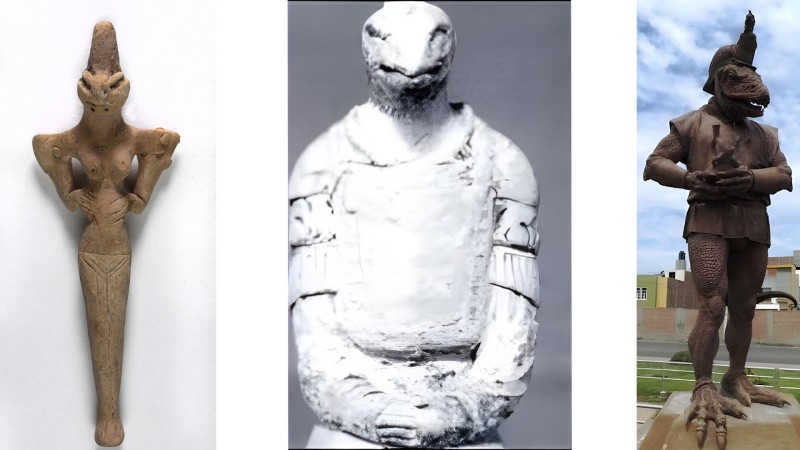Hidden in Time: Fossil Footprints, Reptilian Legends, and the UAP Connection

"Evolution is not a ladder of progress but a branching tree of possibilities." - Richard Dawkins
Could ancient beings have walked the Earth, leaving behind fossilized footprints, inspiring myths of intelligent reptilian humanoids, and even explaining modern UAP sightings?
The idea may seem extraordinary, but the clues are all around us. From the fossilized impressions of upright, bipedal crocodilian-like creatures to the mysterious statues unearthed in Japan, Iraq, and Peru—depictions of reptilian humanoids stretch across cultures and continents. These figures weren’t imagined in isolation. They may reflect a collective memory of an intelligent species that once shared our world.
Paleontologists have identified the species responsible for some of these ancient tracks as Batrachopus grandis, a bipedal crocodilian from over 100 million years ago. But what if that was only the beginning? We now propose a hypothetical descendant: Batrachopus dracosapiens, or “The Upright Crocodilians,” to classify a potential intelligent lineage that evolved in secret. With free forelimbs, upright posture, and possible cognitive development, this species could represent a long-lost branch of Earth’s evolutionary tree—one that may never have gone extinct.
This hypothesis aligns with what we call the Fractalism Framework—the idea that evolution does not follow a single path, but branches into recurring patterns across time and species. Just as primates gave rise to modern humans, it’s plausible that another lineage—reptilian in origin—developed bipedalism, dexterity, and intelligence independently. These may be mirrored iterations, shaped by the same environmental pressures and evolutionary principles.
The Ubaid culture of ancient Mesopotamia, one of humanity’s earliest civilizations, left behind figurines with distinct reptilian features: large eyes, elongated skulls, and humanoid postures. Found in the same region as Eridu, the world’s first city, these statues raise questions about who—or what—the Ubaid people were depicting. Similar figures appear in Mesoamerican temples, Asian shrines, and even among Native American petroglyphs. The consistency is striking.
Fast forward to today. Unidentified Aerial Phenomena (UAPs), once dismissed as science fiction, are now being taken seriously by government agencies and scientists alike. These craft perform maneuvers that defy modern engineering, suggesting an intelligence not bound by our known technologies.
What if the connection is right beneath our feet?
Some theories propose that an ancient, intelligent species may have retreated underground, surviving extinction events and evolving in secret. In isolation, they could have developed advanced technologies and propulsion systems—explaining the origin of UAPs not as extraterrestrial, but as ultra-terrestrial.
Rather than looking outward, the answers may lie within Earth’s own forgotten evolutionary experiments. This isn't just mythology—it’s a scientific possibility. As with the coelacanth, thought extinct for 65 million years before being discovered alive, perhaps Batrachopus dracosapiens continues to elude us because it chooses to.
The fossil record is incomplete. Entire branches of evolution may be lost to time. But when we connect fossilized tracks, ancient myths, and modern aerial phenomena, a single question emerges:
What if they never left?


Leave a comment